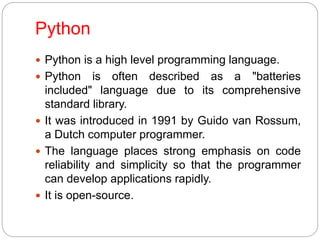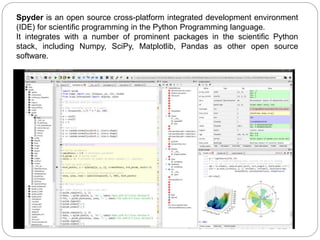Introduction_to_Python.pptx
- 1. Python Programming Language By: Dr. Abhinav Sharma Department of EEE UPES
- 2. Python Python is a high level programming language. Python is often described as a "batteries included" language due to its comprehensive standard library. It was introduced in 1991 by Guido van Rossum, a Dutch computer programmer. The language places strong emphasis on code reliability and simplicity so that the programmer can develop applications rapidly. It is open-source.
- 3. There are large number of programming language like C, C++, Java, but when compared to all these languages Python has simplest syntax. Python is a cross platform language which means that the code written for one operating system like windows will work equally well with Linux, MacOS without any changes.
- 4. Anaconda is a program that consists of python + couple of python libraries. It also has it’s own virtual environment and repository. Jupyter is a Python notebook ("interactive python"). Spyder is just an Integrated Development Environment (IDE) for python. Google Colab notebook executes codes on Google’s cloud server.
- 6. JupyterLab is a web-based interactive development environment for Jupyter notebooks, code, and data. JupyterLab is flexible: configure and arrange the user interface to support a wide range of workflows in data science, scientific computing, and machine learning. JupyterLab is extensible and modular: write plugins that add new components and integrate with existing ones.
- 7. Spyder is an open source cross-platform integrated development environment (IDE) for scientific programming in the Python Programming language. It integrates with a number of prominent packages in the scientific Python stack, including Numpy, SciPy, Matplotlib, Pandas as other open source software.
- 8. Libraries Required for Machine Learning in Python • NumPy • SciPy • Pandas • Matplotlib • fbprophet • TensorFlow • Keras • pylab • Scikit-learn
- 9. Advantages of Python Most programs in Python require considerably less number of lines of code to perform the same task compared to other languages like C. Less Programming time and programming errors.
- 10. Basic datatypes in Python Number- Integers, floating point numbers and complex numbers fall under Python numbers category. They are defined by int, float, complex classes in Python. W can use a type() function to know which class a variable or value belongs to. String- Strings are sequences of character data. String literals may be delimited using either single or double quotes. A string in Python can contain as many characters as you wish. The only limit is your machine’s memory resources. A string can also be empty. List- It is an ordered sequence of items. It is one of the most used datatype in Python and is very flexible. All the items in a list do not need to be of the same type. Declaring a list is pretty straight forward. Items separated by commas are enclosed within brackets. For example- a = [1, 2.2, 'python'].
- 11. Tuple- It is an ordered sequence of items same as a list. The only difference is that tuples are immutable. Tuples once created cannot be modified. Tuples are used to write-protect data and are usually faster than lists as they cannot change dynamically. It is defined within parenthesis () where items are separated by commas. Example: a=(1,2,3+4j,’abc’) We can use a slicing operator [] to extract an item but we cannot change its value. Dictionary- Dictionary is an unordered collection of key-value pairs. It is generally used when we have a huge amount of data. Dictionaries are optimized for retrieving data. We must know the key to retrieve the value. In Python, dictionaries are
- 12. Python Libraries Numpy- It is a Python library which is used for scientific computing. It contains among other things-a powerful array object, mathematical and statistical functions. Pandas- It is a software library written for the Python programming language for data manipulation and analysis. Pandas allows various data manipulation operations such as merging, reshaping, selecting, as well as data cleaning, and data wrangling features. Matplotlib-It is a plotting library for the Python programming language which produces 2D plots to render visualization and helps in exploring the data sets. Matplotlib.pyplot is a collection of command style functions that make matplotlib work like MATLAB.
- 13. Pylab- It is a procedural interface to the Matplotlib object-oriented plotting library. Matplotlib is the whole package; matplotlib.pyplot is a module in Matplotlib; and PyLab is a module that gets installed alongside Matplotlib. PyLab is a convenience module that bulk imports matplotlib.pyplot (for plotting) and NumPy (for Mathematics and working with arrays) in a single name space. Scikit-learn (sklearn)- It is a machine learning library for the Python programming language. It contains various classification, regression and clustering algorithms. Built on NumPy, Scipy and matplotlib, it is designed to interpolate smoothly between the libraries.
- 14. Python io module Python io module allows us to manage the file related input-output operations. The scipy.optimize package provides several commonly used optimization algorithms. The scipy.optimize package provides several commonly used optimization algorithms.










![Basic datatypes in Python
Number- Integers, floating point numbers and complex
numbers fall under Python numbers category. They are
defined by int, float, complex classes in Python. W can
use a type() function to know which class a variable or
value belongs to.
String- Strings are sequences of character data. String
literals may be delimited using either single or double
quotes. A string in Python can contain as many
characters as you wish. The only limit is your machine’s
memory resources. A string can also be empty.
List- It is an ordered sequence of items. It is one of the
most used datatype in Python and is very flexible. All the
items in a list do not need to be of the same type.
Declaring a list is pretty straight forward. Items separated
by commas are enclosed within brackets. For example- a
= [1, 2.2, 'python'].](https://image.slidesharecdn.com/introductiontopython-230717093636-5fb57ea4/85/Introduction_to_Python-pptx-10-320.jpg)
![ Tuple- It is an ordered sequence of items same as
a list. The only difference is that tuples are
immutable. Tuples once created cannot be
modified. Tuples are used to write-protect data and
are usually faster than lists as they cannot change
dynamically. It is defined within parenthesis ()
where items are separated by commas. Example:
a=(1,2,3+4j,’abc’)
We can use a slicing operator [] to extract an item
but we cannot change its value.
Dictionary- Dictionary is an unordered collection of
key-value pairs. It is generally used when we have
a huge amount of data. Dictionaries are optimized
for retrieving data. We must know the key to
retrieve the value. In Python, dictionaries are](https://image.slidesharecdn.com/introductiontopython-230717093636-5fb57ea4/85/Introduction_to_Python-pptx-11-320.jpg)


